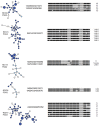Genomic variability of Mycobacterium tuberculosis strains of the Euro-American lineage based on large sequence deletions and 15-locus MIRU-VNTR polymorphism
- PMID: 25197794
- PMCID: PMC4157836
- DOI: 10.1371/journal.pone.0107150
Genomic variability of Mycobacterium tuberculosis strains of the Euro-American lineage based on large sequence deletions and 15-locus MIRU-VNTR polymorphism
Erratum in
- PLoS One. 2014;9(11):e114676
Abstract
A sample of 260 Mycobacterium tuberculosis strains assigned to the Euro-American family was studied to identify phylogenetically informative genomic regions of difference (RD). Mutually exclusive deletions of regions RD115, RD122, RD174, RD182, RD183, RD193, RD219, RD726 and RD761 were found in 202 strains; the RD(Rio) deletion was detected exclusively among the RD174-deleted strains. Although certain deletions were found more frequently in certain spoligotype families (i.e., deletion RD115 in T and LAM, RD174 in LAM, RD182 in Haarlem, RD219 in T and RD726 in the "Cameroon" family), the RD-defined sublineages did not specifically match with spoligotype-defined families, thus arguing against the use of spoligotyping for establishing exact phylogenetic relationships between strains. Notably, when tested for katG463/gyrA95 polymorphism, all the RD-defined sublineages belonged to Principal Genotypic Group (PGG) 2, except sublineage RD219 exclusively belonging to PGG3; the 58 Euro-American strains with no deletion were of either PGG2 or 3. A representative sample of 197 isolates was then analyzed by standard 15-locus MIRU-VNTR typing, a suitable approach to independently assess genetic relationships among the strains. Analysis of the MIRU-VNTR typing results by using a minimum spanning tree (MST) and a classical dendrogram showed groupings that were largely concordant with those obtained by RD-based analysis. Isolates of a given RD profile show, in addition to closely related MIRU-VNTR profiles, related spoligotype profiles that can serve as a basis for better spoligotype-based classification.
Conflict of interest statement
Figures


References
-
- Supply P, Warren RM, Bañuls AL, Lesjean S, Van Der Spuy GD, et al. (2003) Linkage disequilibrium between minisatellite loci supports clonal evolution of Mycobacterium tuberculosis in a high tuberculosis incidence area. Mol Microbiol 47: 529–38. - PubMed
Publication types
MeSH terms
LinkOut - more resources
Full Text Sources
Other Literature Sources
Medical
Miscellaneous

